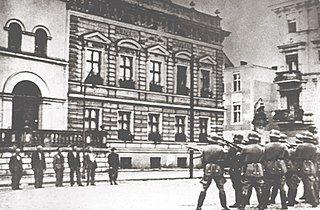
The atomic number or proton number of a chemical element is the number of protons found in the nucleus of every atom of that element. The atomic number uniquely identifies a chemical element. It is identical to the charge number of the nucleus. In an uncharged atom, the atomic number is also equal to the number of electrons.

The Final Solution or the Final Solution to the Jewish Question was a Nazi plan for the genocide of Jews during World War II. The "Final Solution to the Jewish question" was the official code name for the murder of all Jews within reach, which was not restricted to the European continent. This policy of deliberate and systematic genocide starting across German-occupied Europe was formulated in procedural and geopolitical terms by Nazi leadership in January 1942 at the Wannsee Conference held near Berlin, and culminated in the Holocaust, which saw the killing of 90% of Polish Jews, and two thirds of the Jewish population of Europe.

Nazi Germany built extermination camps during the Holocaust in World War II to systematically murder millions of Jews. Others were murdered at the death camps as well, including Poles, homosexuals, Soviet POWs, and Roma. The victims of death camps were primarily killed by gassing, either in permanent installations constructed for this specific purpose or by means of gas vans. Some Nazi camps, such as Auschwitz and Majdanek, served a dual purpose before the end of the war in 1945: extermination by poison gas and also through extreme work under starvation conditions.
Mass media refers to a diverse array of media technologies that reach a large audience via mass communication. The technologies through which this communication takes place include a variety of outlets.

The pound or pound-mass is a unit of mass used in the imperial, United States customary and other systems of measurement. Various definitions have been used; the most common today is the international avoirdupois pound, which is legally defined as exactly 0.45359237 kilograms, and which is divided into 16 avoirdupois ounces. The international standard symbol for the avoirdupois pound is lb; an alternative symbol is lbm, #, and ℔ or ″̶.
The mole (symbol: mol) is the unit of measurement for amount of substance in the International System of Units (SI). It is defined as exactly 6.02214076×1023 constitutive particles, which may be atoms, molecules, ions, or electrons.

Mass is the main eucharistic liturgical service in many forms of Western Christianity. The term Mass is commonly used in the Roman Catholic and Anglican churches, as well as in some Lutheran, Methodist, Western Rite Orthodox, and Old Catholic churches.

A Requiem or Requiem Mass, also known as Mass for the dead or Mass of the dead, is a Mass in the Catholic Church offered for the repose of the soul or souls of one or more deceased persons, using a particular form of the Roman Missal. It is usually, but not necessarily, celebrated in the context of a funeral.

A paperback, also known as a softcover or softback, is a type of book characterized by a thick paper or paperboard cover, and often held together with glue rather than stitches or staples. In contrast, hardcover or hardback books are bound with cardboard covered with cloth, plastic or leather. The pages on the inside are made of paper.

Einsatzgruppen were Schutzstaffel (SS) paramilitary death squads of Nazi Germany that were responsible for mass killings, primarily by shooting, during World War II (1939–45) in German-occupied Europe. The Einsatzgruppen were involved in the murder of much of the intelligentsia, including members of the priesthood, and cultural elite of Poland, and had an integral role in the implementation of the so-called "Final Solution to the Jewish Question" in territories conquered by Nazi Germany. Almost all of the people they killed were civilians, beginning with the intelligentsia and swiftly progressing to Soviet political commissars, Jews, and Romani people as well as actual or alleged partisans throughout Eastern Europe.

Jochen Richard Mass is a German former racing driver.
A mass grave is a grave containing multiple human corpses, which may or may not be identified prior to burial. The United Nations has defined a criminal mass grave as a burial site containing three or more victims of execution. Mass graves are usually created after many people die or are killed, and there is a desire to bury the corpses quickly for sanitation concerns. Although mass graves can be used during major conflicts such as war and crime, in modern times they may be used after a famine, epidemic, or natural disaster. In disasters, mass graves are used for infection and disease control. In such cases, there is often a breakdown of the social infrastructure that would enable proper identification and disposal of individual bodies.
Mass suicide is a form of suicide, occurring when a group of people simultaneously kill themselves.
Hede Massing, née "Hedwig Tune", was an Austrian actress in Vienna and Berlin, communist, and Soviet intelligence operative in Europe and the United States during the 1930s and 1940s. After World War II, she defected from the Soviet underground. She came to prominence by testifying in the second case of Alger Hiss in 1949; later, she published accounts about the underground.

Valley of Death in Fordon, Bydgoszcz, northern Poland, is a site of Nazi German mass murder committed at the beginning of World War II and a mass grave of 1,200 – 1,400 Poles and Jews murdered in October and November 1939 by the local German Selbstschutz and the Gestapo. The murders were a part of Intelligenzaktion in Pomerania, a Nazi action aimed at the elimination of the Polish intelligentsia in Reichsgau Danzig-West Prussia, which included the former Pomeranian Voivodeship. It was part of a larger genocidal action that took place in all German occupied Poland, code-named Operation Tannenberg.
Deutsche Messe was published by Martin Luther in 1526. It followed his work Formula missae from the year 1523, pertaining to the celebration of a Latin mass. Both of these masses were meant only as suggestions made on request and were not expected to be used exactly as they were, but could be altered. The function of the mass, according to Luther, is to make people hear the word.

The Holocaust, also known as the Shoah, was the World War II genocide of the European Jews. Between 1941 and 1945, across German-occupied Europe, Nazi Germany and its collaborators systematically murdered some six million Jews, around two-thirds of Europe's Jewish population. The murders were carried out in pogroms and mass shootings; by a policy of extermination through work in concentration camps; and in gas chambers and gas vans in German extermination camps, chiefly Auschwitz, Bełżec, Chełmno, Majdanek, Sobibór, and Treblinka in occupied Poland.

The Kamianets-Podilskyi massacre was a World War II mass shooting of Jews carried out in the opening stages of Operation Barbarossa, by the German Police Battalion 320 along with Friedrich Jeckeln's Einsatzgruppen, the Hungarian soldiers, and the Ukrainian Auxiliary Police. The killings were conducted on August 27 and August 28, 1941, in the Soviet city of Kamianets-Podilskyi, occupied by German troops in the previous month on July 11, 1941. According to the Nazi German reports a total of 23,600 Jews were murdered, including 16,000 who had earlier been expelled from Hungary.

The Intelligenzaktion, or Intelligentsia mass shootings, was a, not always secret, mass murder conducted by Nazi Germany against the Polish intelligentsia early in the Second World War (1939–45). The operations were conducted to realise the Germanization of the western regions of occupied Poland, before territorial annexation to the German Reich.
A mass shooting is an incident involving multiple victims of firearm violence. There is no widely accepted definition of the term mass shooting. The United States' FBI defines a "mass murder" as "four or more murdered during an event with no "cooling-off period" between the murders." Based on this, it is generally agreed that a mass shooting is whenever four or more people are shot, not including the shooter(s).












